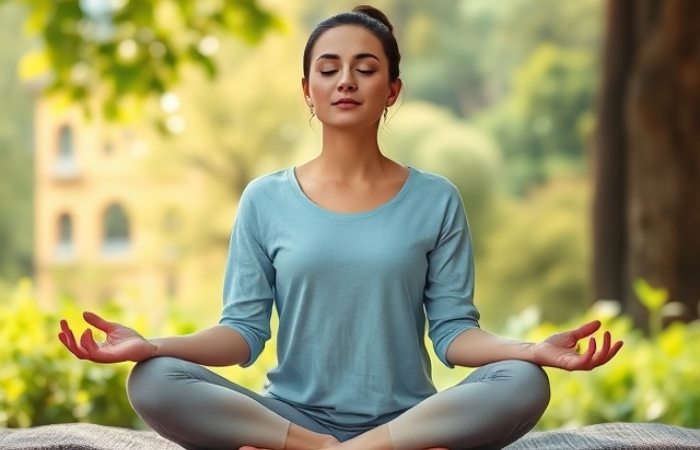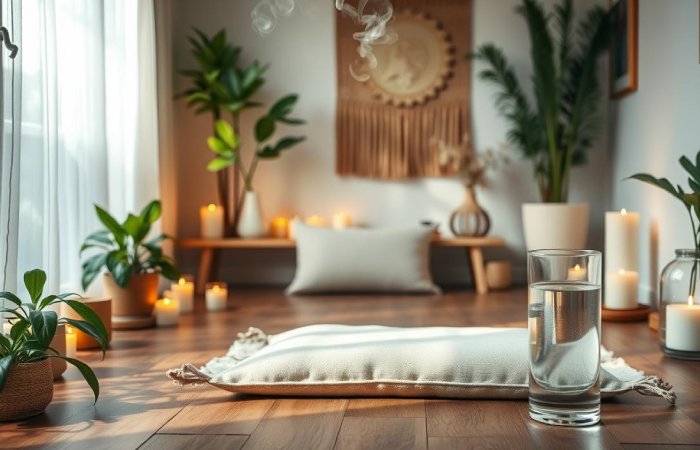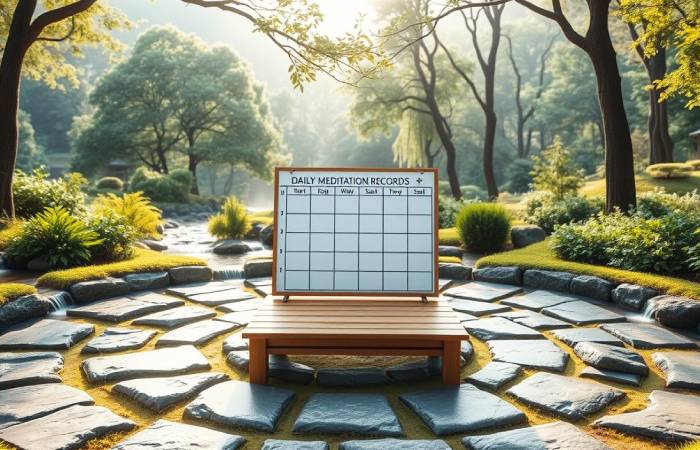In today’s fast world, meditation is more popular than ever. It helps people reduce stress, clear their minds, and find peace. This guide will help you start your meditation journey, whether new or experienced.
Now, meditation has become an element of every life, not only of monks. It is for all the people who intend to improve their well-being. Meditation can be beneficial to the body, mind, and spirit.
This book tells the reader why meditation is good for arranging your space. It will take you through starting, exploring available techniques, working through obstacles, and preparing you to make meditation a day-to-day part of your life by the end.
Key Takeaways
- Meditation offers vast potential to reduce stress, mental muddiness, and inner turmoil.
- The information and techniques in this beginner’s guide will get your meditation practice up and running.
- You will learn preliminary tips on setting up a personal meditation space and the benefits of a daily physio-mental-spiritual practice.
- This guide will also take you step by step on how to get started and how to meditate, dealing with common obstacles to your success.
- You will have learned how to connect meditating practice to daily life so that it becomes sustainable and transformative by the end of this trip.
Understanding the Benefits of Daily Meditation
Meditation is becoming more popular because of its many benefits. It helps both your body and mind. Regular practice can reduce stress, improve focus, and make you happier.
Physical Health Benefits
Research indicates that it indeed helps the body. Even certain diseases are prevented. Blood pressure can even be diminished. It can enhance the immune system. Meditation also helps with pain. It makes it easier to deal with physical issues.
Mental and Emotional Advantages
Meditation is excellent for your mind and feelings. It helps you relax and handle stress better. It makes you more focused and emotionally intense. It also improves your mood and overall happiness.
Spiritual Growth and Self-Discovery
It makes your spirit expand and understand who you are; it makes you much more keen on your thoughts and feelings. This can give you more substantial reasons for life and acceptance of yourself.
Meditation changes you for the better. It offers various rewards to facilitate betterment in all walks of your life. Whether one wants to feel less stressed, focus better, or connect with him or herself, meditation is a rewarding journey.
| Benefit |
Description |
| Stress Relief |
Meditation will decrease stress and anxiety because it teaches the body to be calm and relaxed. |
| Improved Focus |
Regular meditation practice can enhance one’s cognitive skills, like attentive power and concentration power. |
| Enhanced Emotional Well-being |
Meditation enables a person to develop much more emotional resilience and self-awareness. |
| Physical Health Improvements |
Some relations seem to be between meditation, low blood pressure, high immunity, and reasonable control of chronic pain. |
| Spiritual Growth |
Deepening self-understanding and connection with the present moment can be achieved by the practice of meditation. |
Essential Equipment and Setting Up Your Meditation Space
Creating a dedicated meditation space can significantly improve your practice. The right equipment and setup are critical to a calming environment. They help you on your journey to mindfulness and inner peace.
At the center of your space, a meditation cushion is essential. These cushions support your spine and relax your body. Choose one that fits your body and style, from classic zafus to modern benches.
Surround your cushion with zen decor for tranquility. Add candles or Himalayan salt lamps for soft lighting. Plants or stones bring earthy energy. Inspirational art can focus your mind.
Also, consider the space’s temperature and sound. Keep it calm and quiet. Use white noise or natural sounds to block out distractions.
| Essential Meditation Equipment |
Zen Decor Elements |
- Meditation cushion or bench
- Meditation timer
- Incense or essential oils
|
- Candles or salt lamps
- Plants or natural elements
- Inspirational artwork or calligraphy
|
Investing in the right equipment and designing your space thoughtfully creates a sanctuary. It supports your practice and helps you find calm and focus.
How to Start a Meditation Practice: Step-by-Step Guide
Starting a meditation practice might seem challenging, but it’s advantageous. Begin with small steps and grow your practice over time. Here’s a simple guide to help you begin.
Choosing Your Meditation Time
The best time to meditate is when it fits into your life. It doesn’t have to be morning meditation, during lunchtime, or right before bed. There is no specific time for meditation. Try what works well for you.
Basic Posture and Breathing Techniques
The body posture and breathing are assumed for meditation practice. Sit comfortably on a cushion or chair. Set your back straight and let your shoulders relax. Shut your eyes or focus on something before you. Reflect on your breathing exercises. Feel your belly expand and contract when you inhale.
Setting Realistic Goals
Setting goals also keeps one motivated and tracking progress. Begin with 5-10 minutes in the morning or at night. At that point, gradually increase the time once your body is used to the practice, but do remember that it’s always better to be consistent than have a long session, which is usually hard to maintain for a very long period of time.
Do not forget that the way is meaningful, too. This will bring you into constant meditation practice. Be patient and gentle with yourself while discovering meditation.
Different Types of Meditation for Beginners
Meditation is an exciting thing to start with. There are many different practices, from mindfulness meditation to guided visualization. They all have benefits and may help you decide what is best for you.
1. Mindfulness meditation:

A favorite of beginners, keeps you in the here and now, noticing what comes and goes into thoughts and feelings without judgment. This practice can lower stress, improve focus, and bring peace.
2. Guided visualization:

It is another excellent option. It uses a teacher’s voice or a recording to guide you through a scene. This is good for those who struggle to quiet their minds. It can also help with specific goals, like reducing anxiety.
3. Body scan meditation:

It is also great for beginners. It focuses on each body part, helping you understand your physical needs. This practice promotes a deeper connection with your body.
| Meditation Type |
Key Benefits |
| Mindfulness Meditation |
Reduces stress, improves focus, cultivates inner peace |
| Guided Visualization |
It helps quiet the mind and addresses specific goals. |
| Body Scan Meditation |
Develops body awareness promotes embodiment. |
It’s a form of experimentation to determine which meditation is proper for you. Fear not and let it evolve as you do because, with an open mind, the most natural meditation will find you.
“The beauty of meditation is that its use is open to all, regardless of experience or background. It is simply a practice: find something that speaks to you and stick with it.”
Common Challenges and How to Overcome Them
Actually, one can find the birth of a meditation journey that changes life; however, it is in no way a smooth process. Many novices find wandering thoughts, scarce time, and adhering to a schedule to be problems, but one can be better if beaten with the right approach and persistence.
Dealing with Wandering Thoughts
Many beginners get really frustrated when thoughts appear during meditation. It’s also expected to get carried away; it is the technique of bringing the attention gently back to the breath or the present moment without getting upset. Actually, meditation is the practice, not the performance. So, be good to yourself and celebrate little victories.
Managing Time Constraints
Finding time for meditation in our busy lives is tough. But the benefits are worth it. Start with short sessions and gradually increase them as you get more comfortable. Even a few minutes daily can significantly impact your mindfulness and happiness. Remember, consistency is vital for a lasting meditation habit.
Maintaining Consistency
Often, it’s tough to keep up with meditation. Once things get busy, meditation takes the fall. In an attempt to make it a habitual part of the routine, as one does while brushing one’s teeth, having a meditation buddy or an online group will help stick to the practice.
Take mindfulness seriously unless you’re so careless that you forget to meditate.
“The secret of getting ahead is getting started. The secret of getting started is concentrating on the ultimate goal and breaking it down into smaller tasks to start working.”
– Mark Twain
These everyday meditation struggles and mindfulness challenges can be overcome with patience and a positive attitude in building up a strong meditation tips practice. Indeed, the journey is just as important as the goal; take pride in your steps and enjoy the ride while celebrating the journey.
Building a Sustainable Meditation Routine

Form a meditation habit and stick to a daily routine for consistency while meditating. Make meditation flow seamlessly through your daily life so the practice becomes integral to you. Keep yourself motivated and adjust your methods as you grow.
Set a proper time and place. Choose a specific hour during the day to meditate, be it early morning, lunch break, or bedtime. Even a quiet corner is a special place for meditation that speaks to the brain; it’s time to slow down, focus, and obey.
As you get better, don’t be afraid to try new meditation styles and extend your sessions. What suits you today might change later. Be adaptable and let your body and mind guide you, slowly increasing your meditation time as you become more skilled.
- Establish a consistent meditation schedule.
- Create a dedicated meditation space.
- Experiment with different meditation techniques.
- Gradually increase the duration of your practice.
Building up a proper routine is a process of self-discovery: do not become impatient and keep on trying and being gentle with yourself. Never aim at being the best, but do make progress. Through effort and commitment, meditation is a beneficial addition to your daily routine, enhancing meditation habits, practice, and consistency.
Integrating Meditation with Daily Life
Mindfulness and living mindfully are more than just meditation. They can be part of your daily life. Adding meditation to your daily tasks makes you feel more present and aware.
Mindfulness Throughout the Day
First of all, do an excellent short meditation first thing in the morning. Then, continue finding opportunities in your daily activities to practice mindfulness while walking, eating, or taking deep breaths.
Combining Meditation with Other Activities
Try to mix meditation in daily activities with your daily tasks. For example, you can practice mindful breathing while waiting in line or heading to work. So, you may connect your meditation with conscious living.
Creating Mindful Moments
Identify mindful moments for the day. Sometimes, this takes a few deep breaths or pays attention to the surroundings or task and, therefore, makes the day more present and conscious.
Adding meditation and mindfulness to your daily activities adds much to your practice. It keeps your day balanced and fulfilling. Small, mindful changes can add up to a more rewarding lifestyle.
Tracking Progress and Measuring Success

It is a path of self-discovery to begin a meditation practice. Tracking your progress and measuring success is crucial. This section will look at ways to monitor your meditation journey, like using a meditation journal or mindfulness apps.
The Power of Journaling
Keeping a journal to track your process can be very useful. Record all your thoughts and insights after each session. This helps you see how your practice changes over time.
A meditation journal can show patterns, celebrate milestones, and help with challenges. It’s a powerful tool for personal growth.
Leveraging Mindfulness Apps
Today, many mindfulness apps help track your meditation progress. These apps have timers, tracking, and data tools. They help you understand your habits and find areas to improve.
Setting Personal Benchmarks
Setting your own goals is also crucial. You might track session length, practice frequency, or emotional changes. Personal goals help you celebrate your achievements and stay motivated.
| Metric |
Benefit |
| Duration of Meditation Sessions |
Measure your ability to sustain focus and concentration over time |
| Frequency of Practice |
Assess your commitment and consistency to your meditation practice. |
| Emotional and Physiological Changes |
Observe the impact of meditation on your overall well-being. |
The journey of meditation is personal, and success is about how it improves your life. By tracking and celebrating your progress, you stay motivated. This way, you can enjoy the many benefits of regular meditation practice.
Conclusion
This guide has shown you the excellent benefits of regular meditation. It improves your physical health, mental state, and spiritual growth. Mindfulness truly has incredible power.
Your meditation journey is unique and personal. It offers chances for growth, reflection, and peace. Whether new or experienced, remember that the journey has ups and downs.
Accept the changes in your meditation practice. With each session, you move closer to a more fulfilling life. The insights and changes you’ll experience are life-changing. Start this meditation benefits path with an open heart and a curious mind.
FAQ
What is meditation, and how is it beneficial?
Meditation is a practice where you promote your physical, mental, and emotional health. This promotes better self-control, decreases stress levels, and helps develop a better understanding of oneself and others.
What is the most accessible kind of meditation for beginners?
For starters, mindfulness meditation and focused breathing are an excellent place to start. Such practices are easy to learn and lay a foundation for further profound practice.
How do I create a comfortable meditation space?
Create a calm space for meditation. Use comfy cushions or chairs, soft lights, and plants or candles. Find what makes you feel relaxed and focused.
How much time should each person dedicate to meditation per day?
Begin with 5-10 minutes a day. Increase the time as you get accustomed to the practice—correlate consistency rather than time sessions.
What potentially difficult experiences would occur when I begin a meditation practice?
You might struggle with wandering thoughts, finding time, or staying motivated. Be patient and try different techniques. Embrace the journey and growth.
How would you track your progress and try to measure the result of meditation?
Use a journal mindfulness app, or make personal goals. Observe your well-being improvements, such as lowering stress and increasing focus. Reward yourself for small victories to keep moving forward.